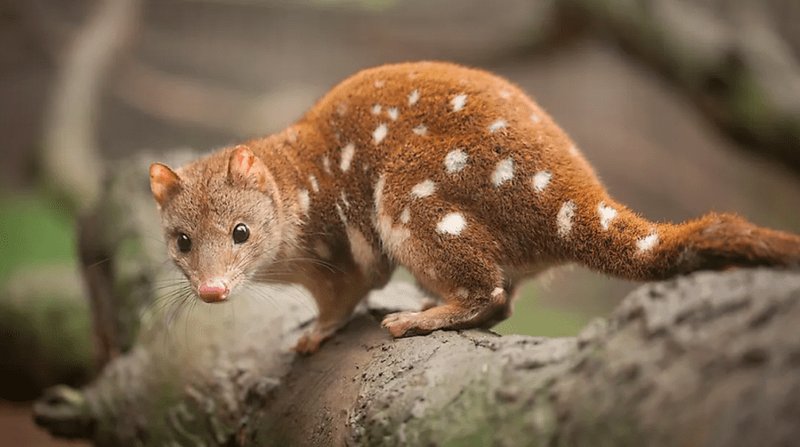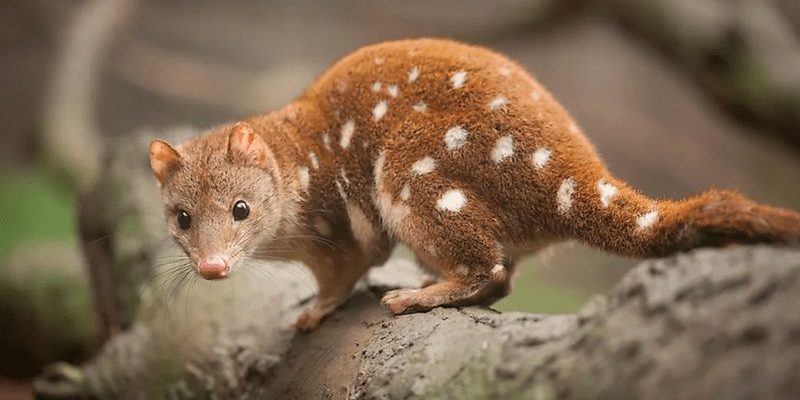
So, what’s the deal? The quoll, with its nocturnal habits and spotted fur, has a few lookalikes that might catch your eye in the wild. It’s like walking into a room full of people who share the same hairstyle; you start to notice the subtle differences that set them apart. In this article, we’ll explore ten animals that share characteristics with the quoll while diving into their unique traits to help you distinguish between them. Let’s uncover these fascinating creatures together!
The Eastern Quoll
The Eastern Quoll (Dasyurus viverrinus) is often confused with its cousin, the spotted quoll. This cute marsupial has a similar body shape but comes in different colors, most notably a striking white and brown fur pattern. You might find them hanging out in forested areas, munching on insects, small mammals, and fruits.
One key difference between the Eastern quoll and the spotted quoll is the size; the Eastern quoll is generally smaller. Their fur also has less noticeable spots compared to the dappled pattern of the spotted quoll. If you see a quoll with more prominent white markings on its fur, chances are, you’re looking at an Eastern quoll!
The Spotted-Tailed Quoll
Next up is the Spotted-Tailed Quoll (Dasyurus maculatus), often called the tiger quoll. This larger relative can grow up to 1 meter long, including its tail, making it the biggest of the quoll family. What sets the spotted-tailed quoll apart is its, well, spectacular tail, which is covered in white spots. You might be wondering if this beauty is just a quoll on steroids, but it has its own habitat preferences and dietary habits.
While the spotted-tailed quoll shares the quoll’s overall shape, it has a much more robust body. You’ll typically find them in wetter, dense forests, hunting for prey like birds and reptiles. So, if you spot a quoll with a longer body and a tail generously sprinkled with white spots, that’s your spotted-tailed quoll!
The Tasmanian Devil
Ah, the Tasmanian Devil (Sarcophilus harrisii), a creature that might remind you of the quoll with its stocky build and dark fur. These little devils are known for their loud, haunting calls and fierce temperament, which is quite a contrast to the quoll’s playful nature. Both animals are marsupials, but the Tasmanian devil is larger and has a more intimidating appearance.
One major difference is in their diet; while quolls are more omnivorous, tasmanian devils feed primarily on carrion. Their fur is also black, with white markings on their chest and face, making them easy to tell apart. If you’re looking at a creature that looks like a quoll but seems a bit… devilish, chances are, it’s a Tasmanian devil lurking around!
The Bandicoot
Let’s also talk about the Bandicoot, a small marsupial that shares some similarities with the quoll but has a distinct look. Bandicoots have longer snouts and smaller eyes, giving them a more rat-like appearance. They often have a sandy or brownish fur coat, which differs from the quoll’s spotted fur.
What really sets the bandicoot apart is its behavior. While quolls are more arboreal, bandicoots tend to stick to the ground, foraging for insects and plant material. Their hopping movements can also make them appear quite different from the graceful motions of a quoll. So, if you see a snouty little creature digging around, you’re likely looking at a bandicoot, not a quoll!
The Sugar Glider
Now, let’s glide into the world of the Sugar Glider (Petaurus breviceps). While this adorable marsupial isn’t a direct relative of the quoll, they both share a love for trees and nocturnal lifestyles. The sugar glider is much smaller and has a unique membrane that allows it to glide through the air, something a quoll certainly can’t do!
The notable differences are in size, shape, and lifestyle. Sugar gliders have large eyes, a more rounded face, and a grayish-brown fur coat with a white patch on their belly. They primarily feast on nectar, fruits, and insects, whereas quolls are more carnivorous. If you see a critter zipping from branch to branch with a flying leap, you’re definitely witnessing the grace of a sugar glider!
The Native Possum
Another animal to consider is the Common Brushtail Possum (Trichosurus vulpecula). This cute marsupial has fluffy tails and fur that ranges from gray to brown. The brushtail possum is known for its adaptability and is often seen in urban areas. Although they’re generally larger than quolls, their playful demeanor can sometimes confuse onlookers.
One way to tell them apart is by their behavior. Brushtail possums tend to be more herbivorous, munching on leaves and fruits. In comparison, quolls are expert hunters looking for small animals. So, if you spot a furry creature munching on a fruit tree, it’s more likely to be a brushtail possum than a quoll!
The Kinkajou
Let’s travel a bit further and talk about the Kinkajou (Potos flavus). Although they’re not native to Australia, kinkajous sometimes get mentioned alongside quolls due to their small size and nocturnal habits. Kinkajous have distinct, round faces and long, prehensile tails, allowing them to navigate the treetops with ease.
The biggest difference? Kinkajous are strictly fruit eaters, mainly consuming nectar and fruits, unlike quolls, who prefer protein. Their facial features and type of movement can help you identify them easily. If you’re looking at a creature with a long, curvy tail hanging upside down, that’s most likely a kinkajou and not a quoll!
The Opossum
Last but not least, the Opossum (Didelphis virginiana) is another animal worthy of mention. While opossums are often associated with North America, they share similarities in appearance with quolls. Opossums have a pointed snout and are more robust with a grayish coat and white face.
One of their most notable differences is their behavior; opossums are known for playing dead when threatened, which is quite different from the quoll’s active hunting style. If you see a creature shimmying through the underbrush, checking for food, and looking a bit like a quoll but more on the chunky side, that’s your opossum!
Final Thoughts
So, there you have it! Identifying these animals similar to the quoll can be a fun and enlightening experience. Each of these creatures has its own unique traits that set them apart, from their size and color to their habits and habitat. Just remember, the next time you’re out in nature, whether you’re hiking through the forest or just hanging out in your backyard, look closely. You might just spot one of these fascinating animals, and now you’ll know exactly what you’re looking at! Happy wildlife watching!

